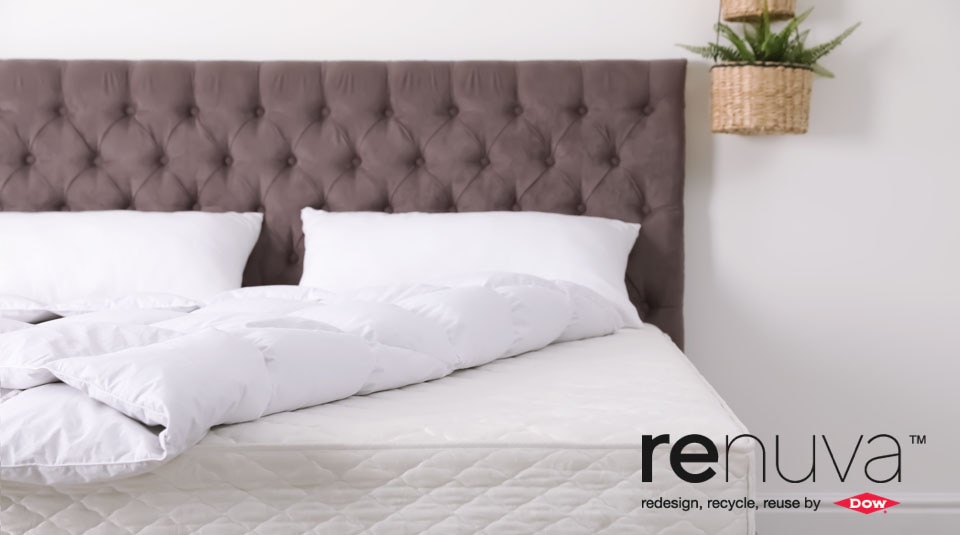
Giving new life to old mattresses
Chemically recycling polyurethane foam into raw material
If stacked, mattresses discarded in Europe every year would exceed the height of Mount Everest – by 678 times1. Approximately 30 million mattresses are thrown away, and most of this bulky, non-biodegradable waste ends up landfills. Through the RENUVA™ Mattress Recycling Program, Dow plans to reduce this mountain of waste by give polyurethane (PU) foam from old mattresses new life.
Through its RENUVA™ Mattress Recycling Program, Dow aims to reduce this mountain of waste by giving polyurethane (PU) foam from end-of-life mattresses a new life. The program will take discarded mattress foam and turn it back into raw material (polyols) through chemical recycling, the process of converting waste into feedstock. The new raw material will then be used in flexible or rigid foam products to go into applications such as building insulation boards and even new mattresses.
BUSINESS CHALLENGE
Creating a circular economy for mattress foam
"We believe our materials need to be as valuable at the end of their life as they are at the start—and we're addressing the challenge of discarded mattresses head-on."
Ana Carolina Haracemiv
Senior Commercial Director, Industrial Intermediares and Infrastructure
EMEAI Dow Polyurethanes
To tackle the problems of mattress waste, we needed to create a way to close the loop on the polyurethane foams they're made with.
The RENUVA™ program takes discarded PU foams and converts them into feedstock through chemical recycling. The new polyol raw material is then repurposed in flexible or rigid foam products used in building insulation boards or even new mattresses.
This is no simple task. While converting PU foams to polyols is not new, it has never been implemented for post-consumer waster because of the complexity of the value chain and technology. For example, in most countries, there is an absence of adequate waste collection facilities that prevents any stable sourcing for chemical recycling. And, the downstream market for such polyols is limited.
"For this reason, the RENUVA™ Mattress Recycling Program is being established first in France, because it has one of the most advanced regulations and initiatives for mattress recycling,: explaineed Lucie Porcelli, Sustainability Leader for Europe, Middle East, Africa, India, Dow Polyurethanes. "It has already put in place Extended Producer Responsbility (EPR) schemes for furniture and matrresses to facilitate a separate collection of waster and support recovery and recycling of different materials."
The program supports Dow’s 2025 “Advancing a Circular Economy” Sustainability Goal, as well some of the circular economy goals set out in the European Union’s Green Deal. In addition, the process has the potential to substantially improve the carbon footprint of flexible foam production for mattresses – up to 30%, according to initial life cycle assessments.
SOLUTION
Innovating for impact
"We consider the RENUVA™ Mattress Recycling Program to just be the beginning. By demonstrating that polyurethanes can be recycled when the right eco-system exists, we hope to stimulate the entire PU industry and create more demand for a prorcess that could then be extended to other markets."
Marcel Moeller
Global Marketing and Sustainability Director
Dow Polyurethanes
To close this challenging resource loop, Dow has adopted an integrated approach to collaborate with value chain partners. Progress to date includes:
Developing a commercially viable recycling method
Since 2017, Dow partnered with the German-based H&S Anlagentechnik to supply the turnkey installation and process know-how for RENUVA™ polyols. Specific chemical recycling recipes have been developed to tailor the resulting RENUVA™ polyol for different applications and to optimize performance and maximize the utilization of the polyol in new foam formulations.
Scaling production
In May 2020, Dow announced it would build an industrial-scale production unit for recycling end-of-life foam at Orrion Chemicals Orgaform in Semoy, France. The installation is expected to take place during the second half of 2020, with the first batch of RENUVA™ polyols expected to be delivered in the first half of 2021.
Sourcing recycled material
This month, Dow announced a new collaboration with Eco-mobilier. The French mattress and furniture EPR organization will supply polyurethane foam from post-consumer mattresses to the recycling unit in Semoy.
The program supports Dow’s 2025 “Advancing a Circular Economy” Sustainability Goal, as well some of the circular economy goals set out in the European Union’s Green Deal. In addition, the process has the potential to substantially improve the carbon footprint of flexible foam production for mattresses – up to 30%, according to initial life cycle assessments.
To learn more about Dow’s focus on the circular economy, read our 2019 Sustainability Report.
1 Assuming an average mattress height of 20 cm; height of Mount Everest is 8,848 m
The RENUVA™ Mattress Recycling Program
Learn more about the collaborative approach behind the RENUVA™ Mattress Recycling Program.

Waking Up to a Better Tomorrow






